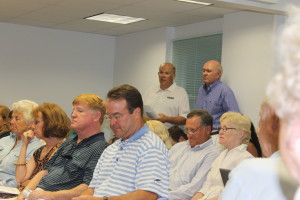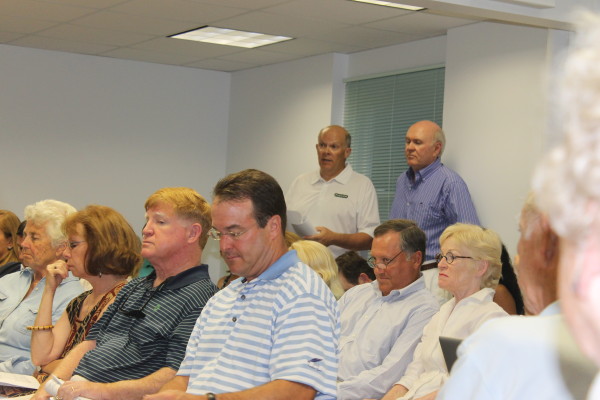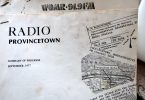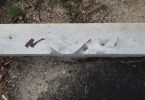
Robert Taft, who owns a home on Pequossett Avenue, was one of the crowd of neighbors telling the Falmouth Historical Commission this week that they do not want historic protection for their neighborhood. “Megansett has self-disciplined itself on preserving architecturally significant buildings for a long time,” he said.
FALMOUTH – As more than one person pointed out, the irony was rich. About a 20 people interested in saving the historic Nimrod building waited last night while about 40 mostly summer residents from Megansett explained to the Falmouth Historical Commission why they are not interested in the commission’s help in preserving the historic integrity of their neighborhood.
At the request of many of those gathered in a tight space in town hall, the commission after an hour and a half voted to continue the meeting to another date, which they did not specify.
The Megansett neighborhood issue stems from a survey that a preservation consultant did several years ago of houses in Falmouth built from 1850 and 1930. The consultant gave the historical commission a list of houses deemed historically significant.
Historical Commission vice chairman Nancy Hayward, who was chairing the meeting in the absence of chairman Heidi Walz, said, “The intent is to preserve and protect significant buildings in town which constitute and reflect significant features and limit the detrimental effect of demolition on the character of the town.”
But the neighbors were having none of it. They insisted their homes were not historically significant and that they were capable of self-regulating the character of the neighborhood. Further, several people said the newer homes were as nice, if not nicer, than the older homes in the neighborhood.
If the historical commission approves houses for the town’s List of Significant Buildings, that would put them under the Demolition Delay Bylaw, meaning the property owner would have to wait six months before demolishing the house. The six-month delay, which was voted in by Falmouth Town Meeting members in 2007 is designed to give the historical commission time to document the building before it is torn down and the community time to determine whether there are other options besides demolition, like moving the house. It also serves to alert neighbors in advance that a historic home is being torn down in their neighborhood.
Many of those gathered were confused about the process that the historical commission was following. They asked to be able to have access to the consultant’s report so that they could know why their house was deemed significant. Several said their houses have been renovated over the years and no longer have anything historic about them.
Hayward said the commission is most interested in the architecture of a house, not what interior renovations have taken place. She said she had tried to get the consultant’s report put on the town’s website but was unable to get that accomplished by town staff in time for the meeting. “I’m not computer literate,” she said.
Matthew Botica, who owns property on Abbies Lane, said that extensive renovations meant that his house should not be on the list. “Any historic value it may have had simply doesn’t exist today,” he said. Furthermore, he said there were new homes on either side of his home and they have enhanced the neighborhood. “It’s made the community a better place by having nice new homes here,” he said.
He said that neighbors trusted each other to preserve the neighborhood much more than they trusted a government agency.
He objected that the commission had not given neighbors access to the consultants document. “Common sense says you have to tell us why we’re here,” he said.
One neighbor said he planned to file for a tax abatement if his home ends up on the list.
Commission member Richard Sacchetti said he lives in Menauhant and he had in the past also questioned the value of being listed under the demolition delay bylaw. In fact, he said, he wanted to be on the historical commission because of his concerns about the demolition delay bylaw. But subsequently, he said, three homes have been demolished in his neighborhood and a “monstrosity” has been built and now he understands the purpose of the bylaw.
But Sacchetti said, he agrees with neighbors who protest the bylaw. “I agree it is a property taking without due process,” he said. “I think you should file an abatement if you can show that the value has decreased.”
Stacey Naumes, who owns a home on Otis Street, said she had been told by a town employee to send the historical commission a letter if she did not want her home on the list.
Hayward said she is not well versed in all the legalities of the bylaw but she believed the historical commission had the ability to list a house on the inventory despite a homeowner’s objection.
“We were misinformed,” Naumes said.
William Bearce, who owns a home on Otis Road, was one of several people who suggested the historical commission start over on the process by posting information on its web page, renoticing the neighbors and explaining more thoroughly what the process is going forward.
Neil Martin, an architect who owns a home in Megansett, said that the neighbors should be told the credentials of the consultant who compiled the list and perhaps be given a Powerpoint presentation about the demolition delay bylaw.
He said most of the houses in Megansett are kit houses from Sears Roebuck. “I don’t see the individual significance of the homes,” he said.
Hayward said there are no architects on the historical commission and they would be interested in knowing more about the kit houses.
Lisa Keating who owns a home on County Road and part of a family home on Foster Road said, “There is nothing historic about our home. It is over-reaching and a taking of property we live in.”
Leslie MacDonald, a former Falmouth Historical Commission member who was at the meeting to talk about another agenda item, the Nimrod, sought to rebut the neighbors anti-historic sentiments. “There are many people who are honored by [the historically significant] designation,” she said.
Robert Taft, who owns a home on Pequossett Avenue, said, “Megansett has self-disciplined itself on preserving architecturally significant buildings for a long time.” As an example, he said his own house was “rebuilt completely” and designed to blend into the community. He said people are “nervous and apprehensive” about having bureaucrats regulate what they can do with their homes.
Attorney Robert Ament said he represents a dozen property owners in Megansett who are upset about the possible designations and that there were clearly problems procedurally. “You really need to start all over again,” he said to the commission members.
“I’m sorry the historical commission does not have a lawyer like you,” Hayward responded.
– Laura M. Reckford






























